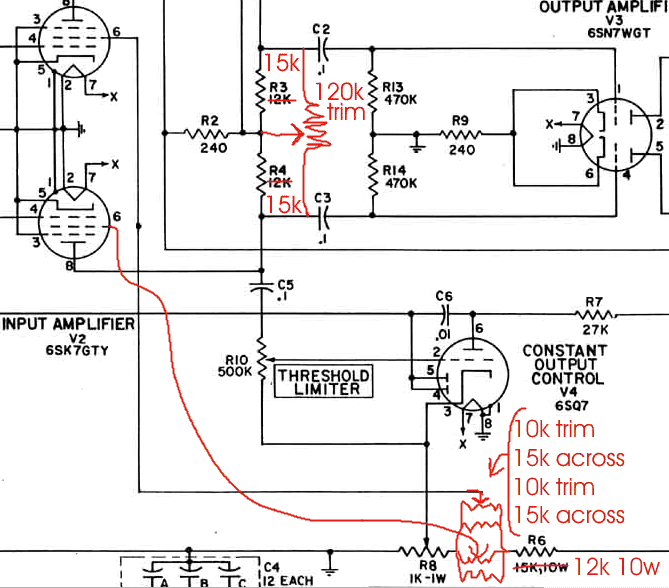PRR explaned nicely in this tread:
http://www.groupdiy.com/index.php?topic=10097.0
................................
"> I think a regulated power supply would be a good idea.
For a simple sidechain and broadcast-standard limiting level, you need to regulate, only the vari-gain stage (and only the G2 of pentodes). The output level rises until the gain is reduced enough. The amount of grid voltage needed for any given gain reduction is a function of plate/G2 voltage. 12AU7 working at 100V on the plates will give a lot of gain reduction at -7V on the grids; if run at 300V on the plates it needs -15 or -20V on the grids for similar gain reduction. Or simply: 1dB output level accuracy needs 10% supply
regulation. In systems that assume fairly steady wall-power, or that don't need consistent limiting level, unregulated supplies worked fine. +/-20% line variation is +/-2dB output limiting level variation: if you just don't want speech to splatt, that's plenty good. If the wall wandered more than 20%, the tube heaters would be unhappy. If the limiter feeds a loudspeaker amp on the same wall power, the
limiter "should" track wall-power wanderings, because the power-amp max output will be shifting too. Finally if you set the limiter
by-ear every time you use it, exact limiting level consistency is pointless unless you also have large wall-power variations during a take or mix. (And if you do, that may be more a problem for other gear than for the limiter.)
If you try to run the vari-gain stage on a low voltage dropped from a high voltage through a resistor, you get a different type of limiter. As vari-gain stage gain drops, stage current drops, voltage drop in the resistor is decreased, supply voltage to the stage rises. This works against you, but is not necessarily bad. Many-many tube limiters work with high-value plate resistors and the plates soar from 60V at idle to 200V at -6dB GR to 230V in deep GR. This softens the knee but can be somewhat compensated by increased gain to the
rectifier and increased rectifier threshold voltage."
..........................
So you probably get a softer knee with the 45K´s wich was not what you want in a Broadcast Limiter.
If you decide to experiment with that please keep us informed about your resultes.























